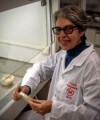Actualidad
Good results of the DCA based on the respiratory quotient for storing pears
The Dynamic Controlled Atmosphere (DCA), monitored by the respiratory quotient, is a method for storing pears that enhances the profile of aromatic volatile compounds and the overall quality of the fruits

The pear (Pyrus communis L., Rosaceae family), a fruit of significant economic importance, exhibits climacteric behavior. As it ripens, its pulp firmness decreases, necessitating specific postharvest handling conditions. Exposure to low temperatures (-1 to 0 °C) can enhance desirable qualities such as a yellowish skin color, a juicy texture, an optimal sugar-acid ratio, and the synthesis of volatile organic compounds, all of which are essential quality attributes. However, prolonged exposure to low temperatures can also induce the development of ethylene autocatalytic production capacity.
CA Storage
Pears stored in controlled atmosphere (CA), which entails lower partial pressure of O2 (pO2), higher partial pressure of CO2 (pCO2), low temperature, and high relative humidity, have demonstrated extended postharvest shelf life in comparison to conventional refrigerated storage.
However, under CA storage, adjustments in pO2 and pCO2 specific to each cultivar can lead to a loss of sensory quality and hinder the development of a pleasant and juicy texture, leading to physiological disorders such as internal browning of the pulp and reduction in the synthesis of aromatic volatile organic compounds.
In recent years, recommendations for pear storage have undergone rapid evolution due to the development of new treatment methods, including Controlled Dynamic Atmosphere (CDA). This innovative technology has shown a superior ability to maintain quality compared to controlled atmosphere storage in various apple cultivars, as well as in kiwi and avocado.
DCA Storage
Dynamic Controlled Atmosphere (DCA) utilizes a lower limit of oxygen tolerated by the fruit, monitored by the respiratory quotient in real-time throughout the storage period. The method also involves measuring ethanol levels, chlorophyll fluorescence emission, and CO2 production. Under these storage conditions at 1.0 °C for six months, fruits exhibited increased pulp firmness and soluble solids, alongside reduced decomposition. Additionally, they did not develop internal disorders while maintaining a buttery and juicy texture.
The production of aromatic volatile organic compounds in pears is crucial for flavor, which significantly influences consumer acceptability. Linear chain esters, particularly butyl acetate and hexyl acetate, contribute to a sweet fruity aroma, with hexyl acetate notably providing the characteristic pear aroma.
Increase in Volatile Compounds
A recent study demonstrated an increase in the majority of ester-type volatile compounds, especially hexyl acetate and butyl acetate, after eight months of storage at -0.5 °C, followed by an additional five days at 20 °C.
These findings indicate that controlled dynamic atmosphere allows for better maintenance of physicochemical quality and imparts a typical aroma to the fruit, proving to be a promising method for pear storage.
Source
Wendt, L. M.; Ludwig, V.; Thewes, F. R.; Soldateli, F. J.; Batista, C. B.; Thewes, F. R.; Fukui, C. M.; Brackmann, A.; Both, V.; Katsurayama, J. M. (2024). Dynamic controlled atmosphere monitored by respiratory quotient as a new method to store pears: Effect on the volatile compounds profile and general quality. Postharvest Biology and Technology, 209: 112721.
Image:
https://www.pensenatural.com.br/pera/ Accessed on 25/03/2024.













